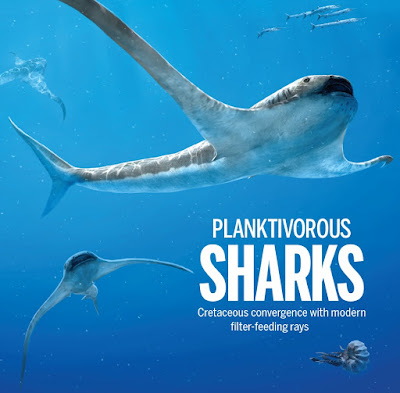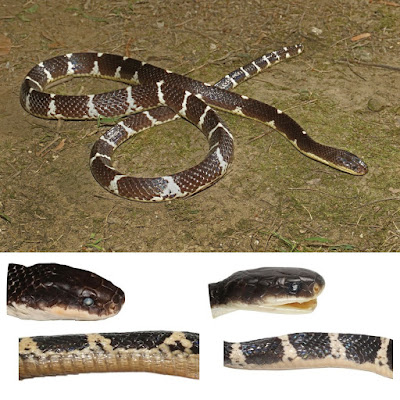[Most Recent Entries] [Calendar View]
Friday, March 19th, 2021
| Time | Event | ||||||
| 4:45a | [PaleoIchthyology • 2021] Aquilolamna milarcae • Manta-like Planktivorous Sharks (Lamniformes: Aquilolamnidae) in Late Cretaceous Oceans Abstract The ecomorphological diversity of extinct elasmobranchs is incompletely known. Here, we describe Aquilolamna milarcae, a bizarre probable planktivorous shark from early Late Cretaceous open marine deposits in Mexico. Aquilolamna, tentatively assigned to Lamniformes, is characterized by hypertrophied, slender pectoral fins. This previously unknown body plan represents an unexpected evolutionary experimentation with underwater flight among sharks, more than 30 million years before the rise of manta and devil rays (Mobulidae), and shows that winglike pectoral fins have evolved independently in two distantly related clades of filter-feeding elasmobranchs. This newly described group of highly specialized long-winged sharks (Aquilolamnidae) displays an aquilopelagic-like ecomorphotype and may have occupied, in late Mesozoic seas, the ecological niche filled by mobulids and other batoids after the Cretaceous–Paleogene boundary. Romain Vullo, Eberhard Frey, Christina Ifrim, Margarito A. González González, Eva S. Stinnesbeck and Wolfgang Stinnesbeck. 2021. Manta-like Planktivorous Sharks in Late Cretaceous Oceans. Science. 371(6535); 1253-1256. DOI: 10.1126/science.abc1490 A soaring shark Modern sharks occupy marine ecosystems across the world but display little morphological diversity, being mostly streamlined predators. Vullo et al. describe a new species of shark from the late Cretaceous that shows that the lack of current variation is not due to limited morphological “exploration” in the past. Specifically, Aquilolamna milarcae displays many features similar to modern manta rays, notably long, slender fins and a mouth seemingly adapted to filter feeding, suggesting that it was planktivorous. This finding indicates both that elasmobranchs evolutionarily experimented with other forms and that the planktivorous “soarers” emerged in this group at least 30 million years earlier than previously recognized. | ||||||
| 9:11a | [Herpetology • 2021] Bungarus suzhenae • Multiple Lines of Evidence Reveal A New Species of Krait (Squamata, Elapidae, Bungarus) from Southwestern China and Northern Myanmar
Abstract Kraits of the genus Bungarus Daudin 1803 are widely known venomous snakes distributed from Iran to China and Indonesia. Here, we use a combination of mitochondrial DNA sequence data and morphological data to describe a new species from Yingjiang County, Yunnan Province, China: Bungarus suzhenae sp. nov. Phylogenetically, this species forms a monophyletic lineage sister to the Bungarus candidus/multicinctus/wanghaotingi complex based on cyt b and ND4 genes but forms a sister species pair with the species B. magnimaculatus Wall & Evans, 1901 based on COI gene fragments. Morphologically, B. suzhenae sp. nov. is similar to the B. candidus/multicinctus/wanghaotingi complex but differs from these taxa by a combination of dental morphology, squamation, coloration pattern, as well as hemipenial morphology. A detailed description of the cranial osteology of the new species is given based on micro-CT tomography images. We revised the morphological characters of B. candidus/multicinctus/wanghaotingi complex and verified the validity of three species in this complex. The distribution of these species was revised; the records of B. candidus in China should be attributed to B. wanghaotingi. We also provide an updated key to species of Bungarus. Keywords: Bungarus suzhenae sp. nov., cranial osteology, hemipenial morphology, micro-computed tomography, phylogeny, taxonomy
Bungarus suzhenae sp. nov. Etymology: The specific epithet of the new species was named after Su-Zhen Bai, a famous powerful goddess of Chinese myth The legend of the White snake (白蛇传), in honor of her courage to true love and kindness to people. The common name is suggested as “Suzhen’s Krait” in English and “素贞环蛇 (sù zhēn huán shé)” in Chinese. งูสามเหลี่ยมไป๋ซู่เจิน Distribution and ecology: Bungarus suzhenae sp. nov. was found in rice fields, streams in monsoon forest at elevation from 800 m to 1,560 m. This species is distributed in Yingjiang Country, Yunnan Province, China and Kachin State, Myanmar (Fig. 1). In captivity, they prey on eels like Monopterus albus and small snakes such Xenochrophis flavipunctatus, Pareas spp., but refuse mice and frogs. Ze-Ning Chen, Sheng-Chao Shi, Gernot Vogel, Li Ding and Jing-Song Shi. 2021. Multiple Lines of Evidence Reveal A New Species of Krait (Squamata, Elapidae, Bungarus) from Southwestern China and Northern Myanmar. ZooKeys. 1025: 35-71. DOI: 10.3897/zookeys.1025.62305 |
| << Previous Day |
2021/03/19 [Calendar] |
Next Day >> |
















